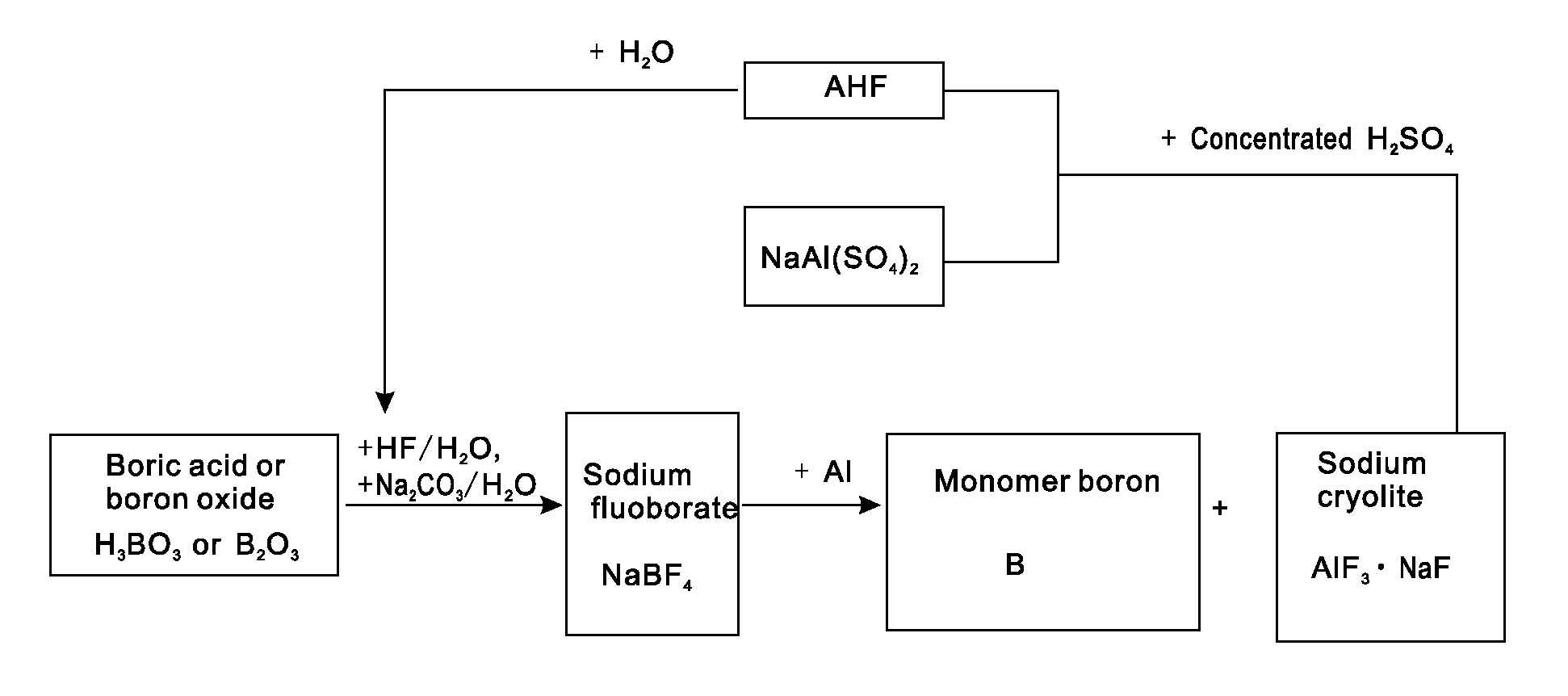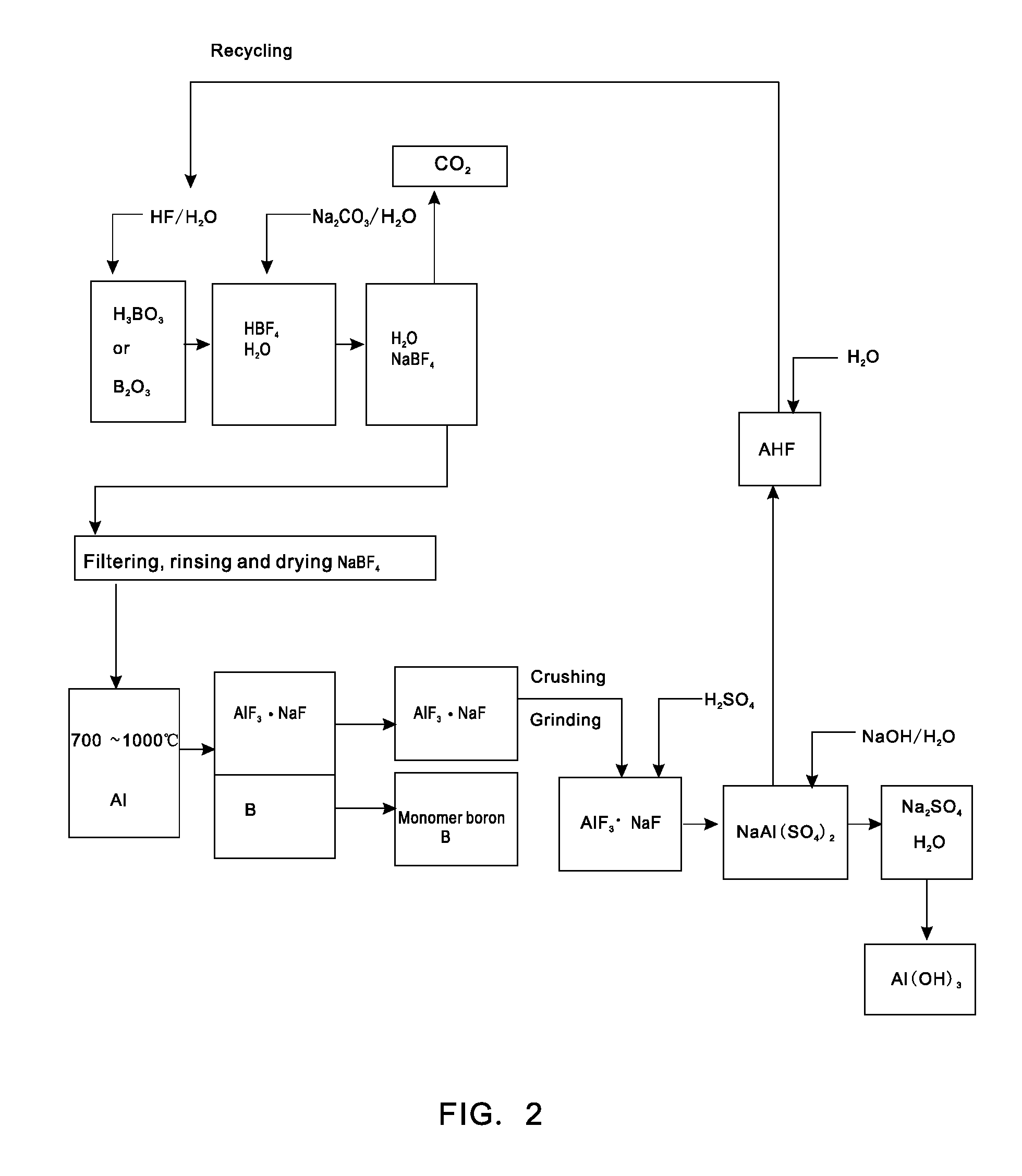Method for cyclically preparing monomer boron and coproducing sodium cryolite using sodium fluoborate as intermediate material
- Summary
- Abstract
- Description
- Claims
- Application Information
AI Technical Summary
Benefits of technology
Problems solved by technology
Method used
Image
Examples
embodiment 1
[0021]Putting 0.62 tons of boric acid and 0.35 tons of boron oxide into a reaction kettle; adding 4 tons of 20% (mass percent) hydrofluoric acid in the reaction kettle to react with the boric acid or boron oxide at a temperature of 100 DEG C to form fluoboric acid; adding 3 tons of 20% (mass percent) sodium carbonate aqueous solution to the fluoboric acid to enable a reaction to form sodium fluoborate; concentrating, crystallizing and rinsing the sodium fluoborate to obtain 0.95 tons of intermediate material sodium fluoborate; putting the 0.95 tons of dried sodium fluoborate into another reactor, injecting argon to the reactor after vacuumizing, heating the reactor to a temperature of 700 DEG C, dripping molten aluminium into the reactor slowly in accordance with a reaction ratio and stirring quickly, wherein the materials are completely reacted after 5 hours and monomer boron and sodium cryolite are generated; extracting molten liquid sodium cryolite, crushing the molten liquid sod...
embodiment 2
[0022]Putting 0.62 tons of boric acid and 0.35 tons of boron oxide into a reaction kettle; adding 4 tons of 20% (mass percent) hydrofluoric acid to the reaction kettle to react with the boric acid or boron oxide at a temperature of 100 DEG C to form fluoboric acid; adding 3 tons of 20% (mass percent) sodium carbonate aqueous solution to the fluoboric acid to enable a reaction to form sodium fluoborate; concentrating, crystallizing and rinsing the sodium fluoborate to obtain 0.95 tons of intermediate material sodium fluoborate; weighing aluminium in accordance with a reaction ratio and putting the aluminium into another reactor, injecting argon to the reactor after vacuumizing, heating the reactor to a temperature of 700 DEG C, adding the 0.95 tons of dried and flowable sodium fluoborate in the reactor in a measurable flowing way and stirring quickly, wherein the materials are completely reacted after 5 hours and monomer boron and sodium cryolite are generated; extracting molten liqu...
PUM
| Property | Measurement | Unit |
|---|---|---|
| Time | aaaaa | aaaaa |
| Flow rate | aaaaa | aaaaa |
Abstract
Description
Claims
Application Information
 Login to View More
Login to View More - R&D
- Intellectual Property
- Life Sciences
- Materials
- Tech Scout
- Unparalleled Data Quality
- Higher Quality Content
- 60% Fewer Hallucinations
Browse by: Latest US Patents, China's latest patents, Technical Efficacy Thesaurus, Application Domain, Technology Topic, Popular Technical Reports.
© 2025 PatSnap. All rights reserved.Legal|Privacy policy|Modern Slavery Act Transparency Statement|Sitemap|About US| Contact US: help@patsnap.com



